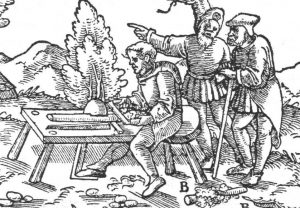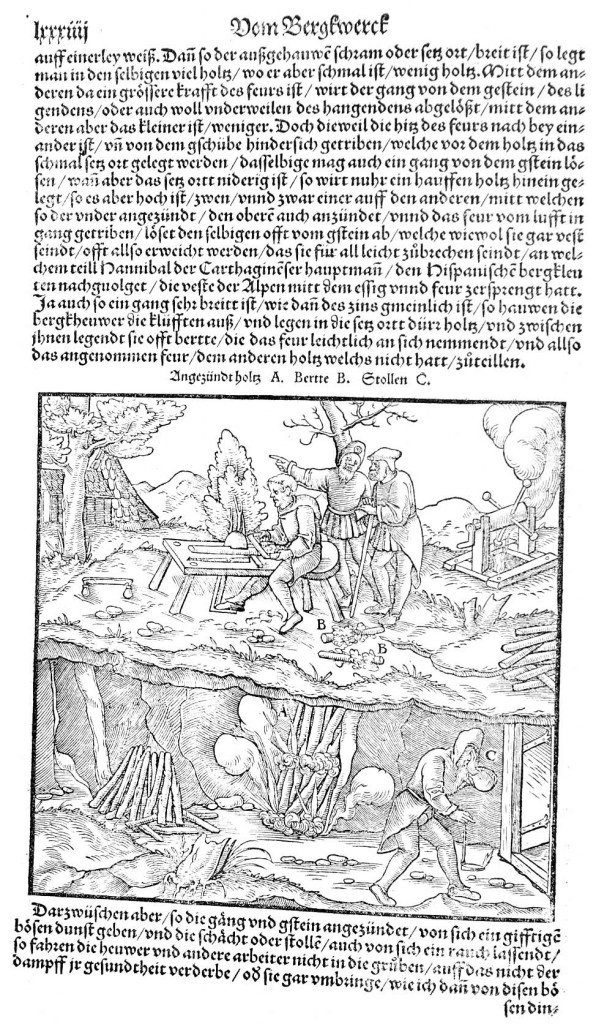We may receive a commission when you use our affiliate links. However, this does not impact our recommendations.
There are some woodworkers who say that shavehorses weren’t used in chairmaking – according to the historical record. But shavehorses were definitely used in the mining industry.
Check out this 1556 illustration of a guy working at a shavehorse from the Latin text “Georgius Agricola: De Re Metallica.” The gentleman looks like he is not-so-merrily shaving away at a chair spindle. Not so.
The guy is making “bertte” – translated as “beards.” These are sticks of wood that are shaved so that all the shavings are still attached. They literally look like beards or a Christmas tree perhaps (after too much egg nog).
These bertte were important to the mining industry because they were used to light fires in the mines that would help make the rock crumble.
Thanks to Gerd Schlottig for the image and the text. He was in my workbench class at Dictum in Bavaria this summer. He holds the distinction of being able to eat an entire piece of bread slathered with a thick skin of marmite. If you have ever tasted a molecule of marmite, then you know that you should be showing respect.
— Christopher Schwarz
Here are some supplies and tools we find essential in our everyday work around the shop. We may receive a commission from sales referred by our links; however, we have carefully selected these products for their usefulness and quality.











Chris, I am very interested in a workup or plans to a Shave Horse. Ever since I started watching Charles Brock’s new WebShow The Highland Woodworker and saw Brian Boggs and what little of his ShaveHorse I am intrigued to get the mechanics of a/some models and how they “vise” clamp wood quickly into place and change or unclamp/reclamp quickly! Could you advise me on direction and possible alternatives?? Thanks, Gary.
Like to read the text in English?
http://archive.org/stream/georgiusagricola00agririch#page/120/mode/2up
Sorry, I don’t know how to make a clickable link, but you all know how to paste this into your browser, right?
Scientific and technological history is one of my little hobbies.
De Re Metallica is very interesting because it is virtually our sole source of information about medieval mining and metal working. Medieval scholars and writers were largely of the nobility and held all non-military practical knowledge and activity in contempt. As a result, they ignore the details of the technologies kept everyone alive. Prior to the 1600s, there is almost no documentation about any non-military technical matter. We know very, very little about the nuts and bolts of the medieval world
It is akin to the way that current intellectuals hold business in contempt and never seriously study it despite pontificating about it endlessly. Just as we struggle to understand how most people in the medieval ages lived and worked I imagine that future generations of historians will struggle to figure out how most of us today (who work in business of one kind of the other) spent our lives.
Elites rarely pay attention to what is truly important.
interesting about shave horse. How about a plan or drawing of how to build a shaving horse?
The text with the picture looks to be German, not Latin. Not that I can read either language anymore.
“Bertte”…fuzz sticks, we call them. It’s one of the first things our Cub Scouts make when we do knife skills. Use them the same way (sans rock crumbling.)
Marmite is for girls. Try Vegemite. It’s a compulsory pantry item in every Australian kitchen. Think axle grease and salt, combined with the yeast of a thousand breweries. Helps put a rose in every cheek!
Cheerio,
Virg.
PS What? Shave horses? Oh yes, that’s nice.
For someone who likes to eat Marmite by the spoon that’s not a big deal. Best thing since sliced bread (with Marmite on)
Marmite: http://www.spurgeon.org/~phil/marmite.htm
Maybe that’s Gerd Schlottig as a child in the picture under the “What is Marmite” link(?).
A quote from the “What is Marmite” section: “It is definitely a love-it-or-hate-it type of food.”
I use my shavehorse for non-furniture work all the time. Most recently I used it, along with a drawknife, to make the 12″ long, 1 1/4″ thick oak pegs for my new timber frame shop. I started out by riving the rough billets, and then shaving them down. Initially I used my broad hatchet, but the shavehorse and drawknife was easier.
Have not and probably will never experience Marmite. However, my shaving horse (from plans by Drew Langsner) is very useful in ‘Rural’ chair making, boat building and other tasks where an item too long for the lathe is being fashioned. Great for making tool handles too!
Hey you guys, I have just had a freshly baked French Baguette with butter and lots of Marmite for lunch, and now I’m fit for work this afternoon. It might be an acquired taste, but I sure did acquire it for Marmite!
You might also like to consider that it is made from a by-product of brewing beer – so get some proper respect gentlemen. For beginners, just put a very little on your bread.
Harry in Nairobi
Shavehorse were definitely used in the rural industry to make furniture, hurdles, brooms, rakes etc. from coppiced wood in the forests as it was cut. A member of my family is featured in the Museum of Rural Craft at Reading University using one here in England. Furniture making like this vanished within months of factories making it were established. Come to that most cabinet makers would have been put out of business in a similar way.
Marmite is a childhood food here usually eaten in small quantities on heavily buttered toast. Applied too thickly it is rather nasty.
Not-so-merrily indeed. It might be time for a Schwartzian version of http://www.theonion.com/articles/grueling-household-tasks-of-19th-century-enjoyed-b,1519/
There is an even older picture of a shavehorse in “die hausbucher der Nürnberger Zwölfbrüderstiftungen”.
The picture is from 1478, and shows a cooper working on a large barrel. There is a shavehorse in the background.
http://www.nuernberger-hausbuecher.de/75-Amb-2-317-97-r/data
Had New Zealand Marmite when there last November. Can’t say it is on the top of my list of edible bread coverings.
Interesting thing is there were stories in the newspaper about the pending Marmite shortage due to the factory shutdown as a result of the 2011 earthquakes.
I was told it was an honor to be able to sample the delicacy before it vanished from the shelves.
They were wrong.